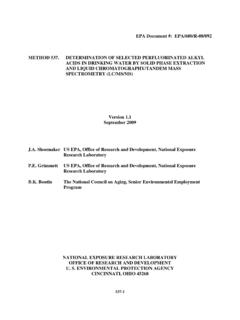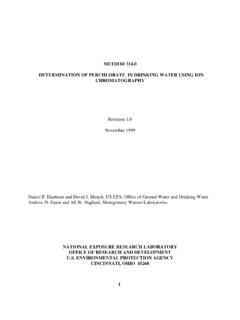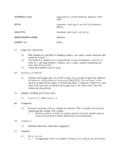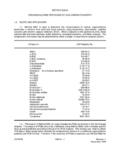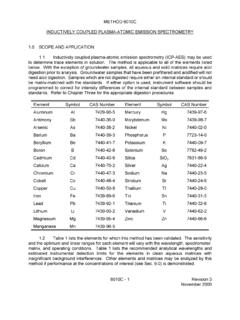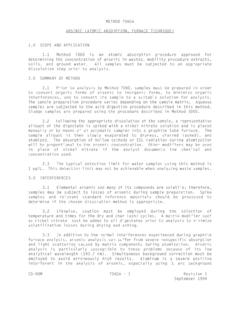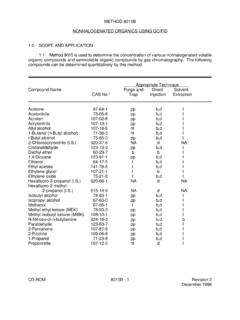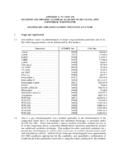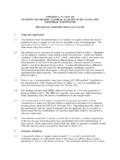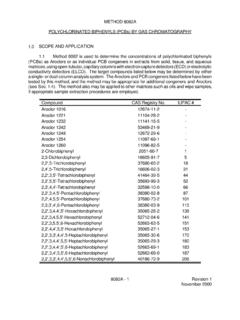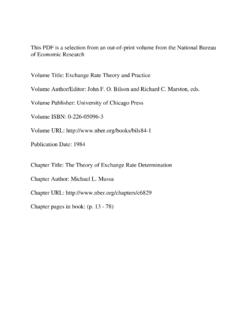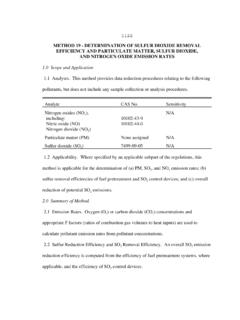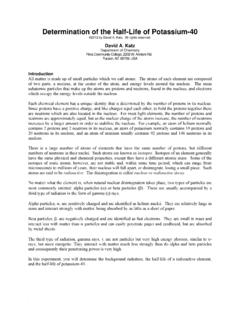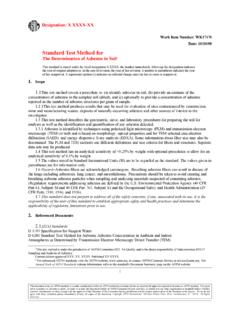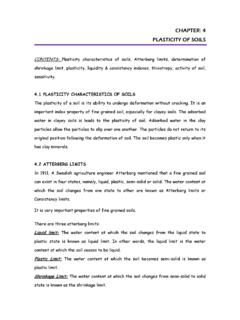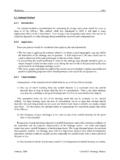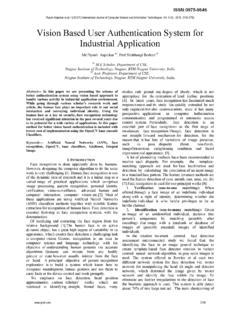Transcription of METHOD 24 - DETERMINATION OF VOLATILE …
1 1180 METHOD 24 - DETERMINATION OF VOLATILE matter content ,WATER content , DENSITY, volume SOLIDS, ANDWEIGHT SOLIDS OF SURFACE Scope and Analytes. AnalyteCAS organic compoundsNo CAS Number Applicability. This METHOD is applicable for thedetermination of VOLATILE matter content , water content ,density, volume solids, and weight solids of paint, varnish,lacquer, or other related surface Precision and Bias. Intra- and inter-laboratoryanalytical precision statements are presented in No bias has been Summary of METHOD . Standard methods are used to determine thevolatile matter content , water content , density, volumesolids, and weight solids of paint, varnish, lacquer, orother related surface Waterborne coating means any coating whichcontains more than 5 percent water by weight in its Multicomponent coatings are coatings that arepackaged in two or more parts, which are combined beforeapplication.
2 Upon combination a coreactant from one part ofthe coating chemically reacts, at ambient conditions, with acoreactant from another part of the coating. Ultraviolet (UV) radiation-cured coatings arecoatings which contain unreacted monomers that arepolymerized by exposure to ultraviolet Interferences. [Reserved] Disclaimer. This METHOD may involve hazardousmaterials, operations, and equipment. This test METHOD maynot address all of the safety problems associated with itsuse. It is the responsibility of the user of this testmethod to establish appropriate safety and health practicesand to determine the applicability of regulatory limitationsprior to performing this test Hazardous Components.
3 Several of the compoundsthat may be contained in the coatings analyzed by thismethod may be irritating or corrosive to tissues ( ,heptane) or may be toxic ( , benzene, methyl alcohol). Nearly all are fire hazards. Appropriate precautions can befound in reference documents, such as Reference 3 of Equipment and Supplies. The equipment and supplies specified in the ASTM methods listed in Sections through (incorporated byreference - see for acceptable versions of themethods) are ASTM D 1475-60, 80, or 90, Standard Test Methodfor Density of Paint, Varnish, Lacquer, and RelatedProducts. ASTM D 2369-81, 87, 90, 92, 93, or 95, StandardTest METHOD for VOLATILE content of Coatings. ASTM D 3792-79 or 91, Standard Test METHOD forWater content of Water Reducible Paints by Direct Injectioninto a Gas Chromatograph.
4 ASTM D 4017-81, 90, or 96a, Standard Test Methodfor Water in Paints and Paint Materials by the Karl FischerTitration METHOD . ASTM 4457-85 (Reapproved 1991), Standard TestMethod for DETERMINATION of Dichloromethane and 1,1,1-Trichloroethane in Paints and Coatings by Direct Injectioninto a Gas Chromatograph. ASTM D 5403-93, Standard Test Methods forVolatile content of Radiation Curable Reagents and The reagents and standards specified in the ASTM methods listed in Sections through are Sample Collection, Preservation, Storage, Follow the sample collection, preservation,storage, and transport procedures described in Reference 1of Section Quality Reproducibility (NOTE: Not applicable to UVradiation-cured coatings).
5 The variety of coatings that maybe subject to analysis makes it necessary to verify theability of the analyst and the analytical procedures toobtain reproducible results for the coatings is accomplished by running duplicate analyseson each sample tested (Sections through ) andcomparing the results with the intra-laboratory precisionstatements (Section ) for each parameter. Confidence Limits for Waterborne Coatings. Because of the inherent increased imprecision in thedetermination of the VOC content of waterborne coatings asthe weight percent of water increases, measured parametersfor waterborne coatings are replaced with appropriateconfidence limits (Section ). These confidence limits1184are based on measured parameters and inter-laboratoryprecision Calibration and Perform the calibration and standardizationprocedures specified in the ASTM methods listed in through Analytical Procedure.
6 Additional guidance can be found in Reference 2 ofSection Non Thin-film Ultraviolet Radiation-cured (UVradiation-cured) Coatings. VOLATILE content . Use the procedure in ASTM D5403 to determine the VOLATILE matter content of the coatingexcept the curing test described in NOTE 2 of ASTM D 5403 Water content . To determine water content ,follow Section Coating Density. To determine coatingdensity, follow Section Solids content . To determine solids content ,follow Section To determine if a coating or ink can beclassified as a thin-film UV cured coating or ink, use theequation in Section If C is less than g and A is1185greater than or equal to 225 cm2 (35 in2) then the coatingor ink is considered a thin-film UV radiation-cured coatingand ASTM D 5403 is not : As noted in Section of ASTM D 5403, thismethod may not be applicable to radiation curable materialswherein the VOLATILE material is Multi-component Sample Prepare about 100 ml of sample by mixing thecomponents in a storage container, such as a glass jar witha screw top or a metal can with a cap.
7 The storagecontainer should be just large enough to hold the mixture. Combine the components (by weight or volume ) in the ratiorecommended by the manufacturer. Tightly close thecontainer between additions and during mixing to preventloss of VOLATILE materials. However, most manufacturersmixing instructions are by volume . Because of possibleerror caused by expansion of the liquid when measuring thevolume, it is recommended that the components be combined byweight. When weight is used to combine the components andthe manufacturer s recommended ratio is by volume , thedensity must be determined by Section Immediately after mixing, take aliquots fromthis 100 ml sample for DETERMINATION of the total volatilecontent, water content , and VOLATILE content .
8 To determine total volatilecontent, use the apparatus and reagents described in ASTMD2369 Sections 3 and 4 (incorporated by reference - see for the approved versions of the standard),respectively, and use the following Weigh and record the weight of an aluminumfoil weighing dish. Add 3 + 1 ml of suitable solvent asspecified in ASTM D2369 to the weighing dish. Using asyringe as specified in ASTM D2369, weigh to 1 mg, bydifference, a sample of coating into the weighing dish. Forcoatings believed to have a VOLATILE content less than 40weight percent, a suitable size is + g, but forcoatings believed to have a VOLATILE content greater than 40weight percent, a suitable size is + : If the VOLATILE content determined pursuant toSection is not in the range corresponding to the samplesize chosen repeat the test with the appropriate samplesize.
9 Add the specimen dropwise, shaking (swirling) thedish to disperse the specimen completely in the solvent. Ifthe material forms a lump that cannot be dispersed, discardthe specimen and prepare a new one. Similarly, prepare a1187duplicate. The sample shall stand for a minimum of 1 hour,but no more than 24 hours prior to being oven cured at 110 + 5EC (230 + 9EF) for 1 hour. Heat the aluminum foil dishes containing thedispersed specimens in the forced draft oven for 60 min at110 + 5EC (230 + 9EF). Caution -- provide adequateventilation, consistent with accepted laboratory practice,to prevent solvent vapors from accumulating to a Remove the dishes from the oven, placeimmediately in a desiccator, cool to ambient temperature,and weigh to within 1 Run analyses in pairs (duplicate sets) foreach coating mixture until the criterion in Section ismet.
10 Calculate Wv following Equation 24-2 and record thearithmetic Water content . To determine water content ,follow Section Coating Density. To determine coatingdensity, follow Section Solids content . To determine solids content ,follow Section Exempt Solvent content . To determine theexempt solvent content , follow Section : For all other coatings ( , water- orsolvent-borne coatings) not covered by multicomponent or UVradiation-cured coatings, analyze as shown Water- or Solvent-borne VOLATILE content . Use the procedure in ASTM D2369 to determine the VOLATILE matter content (may includewater) of the coating. Record the following information:W1 = weight of dish and sample before heating, gW2 = weight of dish and sample after heating, gW3 = sample weight, Calculate the weight fraction of thevolatile matter (Wv) for each analysis as shown in Run duplicate analyses until the differencebetween the two values in a set is less than or equal to theintra-laboratory precision statement in Section Record the arithmetic average ( Wv).
